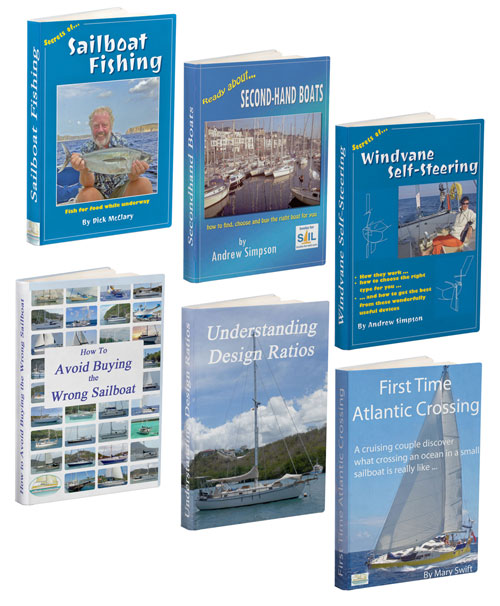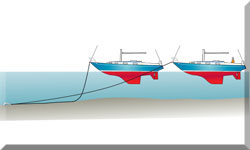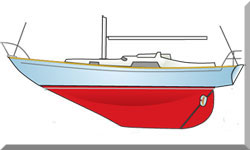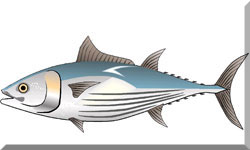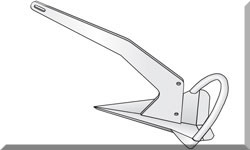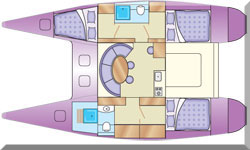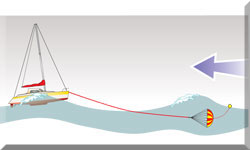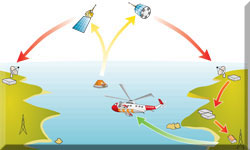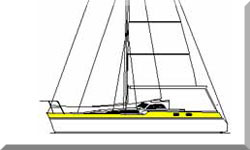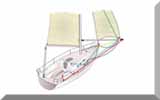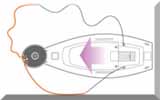- Home
- Bluewater Sailing
The Ultimate Blue Water Sailing Guide: Preparation & Seamanship for the Ocean
In a Nutshell...
Blue water sailing is the ultimate logistical challenge. It demands deep respect for the sea and meticulous preparation of your vessel and its systems. Success absolutely hinges on redundancy, a detailed passage plan, and the financial and technical ability to be entirely self-sufficient for weeks at a time. Get all your systems and supplies in order before you leave the coast behind, because out there, you are truly on your own.
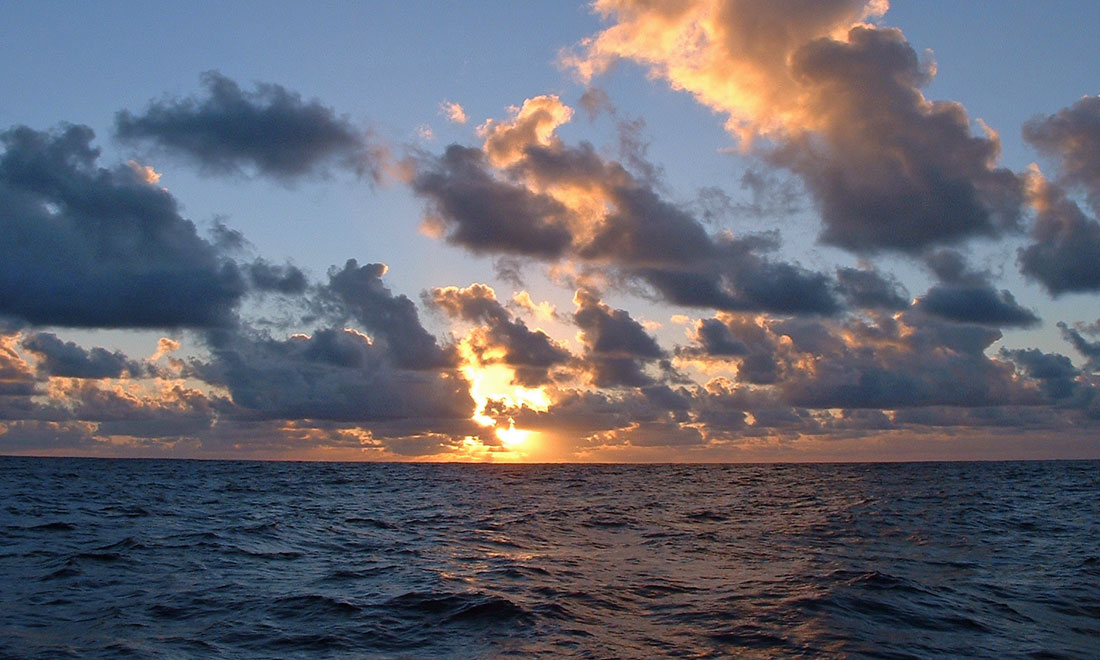 To quote John Masefield, one of England’s most beloved maritime poets, “I must go down to the seas again, to the lonely sea and the sky…”
To quote John Masefield, one of England’s most beloved maritime poets, “I must go down to the seas again, to the lonely sea and the sky…”Table of Contents
- The Lure of the Horizon: Embracing Blue-Water Sailing
- The Vessel: Foundations for Offshore Passage Making
- Planning & Preparation: Laying the Foundation for Success
- Navigation & Weather: Blending the Old & the New
- Safety & Emergency Procedures: Prepared for the Worst
- Onboard Life & Watch Keeping: The Rhythm of the Sea
- Common Passage Making Mistakes & How to Avoid Them
- Arrival & Post-Passage Procedures
- Summing Up
- Frequently Asked Questions (FAQs)
The Lure of the Horizon: Embracing Blue-Water Sailing
The allure of the open ocean promises adventure, solitude, and that profound sense of self-reliance you simply do not find anywhere else. But the sea is a demanding boss, and long-distance cruising requires more than just a dream; it demands a masterclass in logistical mastery and sound, unshakeable judgment. This guide pulls together the essential knowledge you'll need for navigating blue-water with confidence, drawn from my own years as an experienced ocean sailor. It's about knowing your limits, knowing your boat, and having the right plan when things inevitably go sideways.
The Vessel: Foundations for Offshore Passage Making
Before you worry about the weather, you have to be sure you've got the right tool for the job. Your vessel is your life support out there, so its inherent design and structure matter hugely.
Choosing the Right Boat for Blue Water Sailing (Overview)
When you're first looking at blue-water sailing, you soon realise not all sailboats are created equal. An offshore boat must be capable of carrying you safely through a sustained gale and protecting you from a cold, rough sea. Think comfort and safety over pure speed. Generally, you'll be looking for design features like a robust hull, a full or modified long keel for stability and protection, and a protected rudder. A proper blue water boat will have ample tankage for fuel and water and plenty of storage for spares and provisions.
We've covered this in detail over in our article The Essential Features of All Good Cruising Sailboats.
Comparative Analysis of Sailing Rigs for Offshore (Overview)
The rig is your engine, and choosing the right one can make all the difference to short-handed sailing comfort. While a modern sloop is efficient, a rig that is easily handled and reefed often wins offshore. For instance, a cutter rig is highly valued because it allows for a balanced sail plan with a small working jib and a mainsail, ideal for high winds. A ketch offers a split sail plan that reduces the size of the largest sail (the main), making it easier to manage when you're tired or the weather is nasty. For long passages, smaller, more numerous sails mean more flexibility.
For a comprehensive breakdown of the pros and cons of each type of sail plan, have a read of our article: The Ultimate Guide to Sailboats & Rigs: Sloops, Ketches & More.
Planning & Preparation: Laying the Foundation for Success
Before you even think about casting off the dock lines, an almost obsessive level of planning is crucial. This thorough preparation doesn't just lay the groundwork for a safe passage; it drastically minimises the surprises that could become emergencies hundreds of miles from help.
Drafting Your Passage Plan & The Blueprint for Success
Every successful offshore passage begins with a well-crafted plan. This isn't just about drawing a line on a chart; it’s a comprehensive, living document detailing every aspect of your voyage. It’s your operational bible.
A thorough passage plan, which should be worked out in detail, considers factors such as distance, estimated time of arrival, waypoints, potential hazards, and alternative routes. Crucially, it incorporates detailed weather forecasts, tidal information, and port entry procedures, serving as a vital navigational and safety tool. You're mapping out your journey, but you're also pre-empting disaster.
For a detailed breakdown of how to create an effective passage plan, including essential elements and practical examples, you should refer to our dedicated article: Crafting Your Offshore Passage Plan: A Step-by-Step Guide.
Vessel Preparation: Ensuring Seaworthiness & Spares
Your vessel is your primary support system at sea; a thorough pre-passage inspection is absolutely essential. From experience, this is really something you can't do properly with the boat in the water, which is why a haul-out and comprehensive inspection is a must. If you are preparing for a long lay-up afterwards, our guide Preparing Your Sailboat for Storage: The Guide to Hauling Out and Laying-Up offers practical advice on preserving your boat.
The Critical Power System & Charging Redundancy
First, get stuck into your 12V battery bank—it's the heart of your onboard electrical system. Offshore passages demand a reliable power source for navigation, communication, and essential equipment. Confirm the battery bank is in optimal condition, checking for corrosion, proper electrolyte levels, and secure connections.
Equally important are your charging systems. The engine alternator is the primary charging source, but redundancy is prudent, particularly for extended passages where you may not run the engine often. Consider supplemental charging options, such as solar panels or a wind generator. Having multiple, independent ways to charge your batteries isn't a luxury; it's a non-negotiable part of safe long-distance sailing.
| System Component | Pre-Passage Check | Redundancy/Back-up |
|---|---|---|
| Rigging | Inspect for chafe/cracks, test all turnbuckles. | Emergency forestay, robust spare lines. |
| Engine | Full service, check fuel lines/filters, oil levels. | Comprehensive spares kit, backup jerry cans. |
| Power | Test battery banks, check connections. | Solar panels, wind generator, spare regulator. |
| Safety Gear | EPIRB registration, life raft service date, flare expiry. | Grab bag accessible with a PLB, handheld VHF. |
| Steering | Inspect cables, quadrant, autopilot functionality. | Emergency tiller, spare autopilot parts. |
Beyond the electrical systems, inspect the engine, fuel, water, and backup systems. Verify that all safety equipment, including the EPIRB (Emergency Position-Indicating Radio Beacon), life raft, and flares, is readily accessible and fully functional. Our “Condition Survey Checklist” will ensure no critical items are overlooked.
| System Check | Action/Verification | Completed |
|---|---|---|
| Fuel & Engine | Top up fuel tanks; check fuel pre-filters; test bilge pump (engine compartment). | Yes/No |
| Steering | Function-check main wheel/tiller; engage and disengage autopilot; deploy emergency tiller. | Yes/No |
| Security | Confirm all seacocks are operating freely; check deck hatches are sealed and secure. | Yes/No |
| Galley & Cabin | Secure all heavy items (tins, tools); stow loose lines; remove any deck clutter. | Yes/No |
Crew Preparation: Forging a Capable Team
Offshore sailing is a team effort. Select crew members (unless you're a single-hander of course—and if that's you, you might want to check out “Single Handed Sailing: Assessing the Risks and Rewards of Solo Passage Making”) for their skills and, just as importantly, their compatibility. A long passage can test the most patient sailor. Clearly define roles and responsibilities from the start.
Regular training and emergency drills, particularly for man overboard and fire scenarios, are crucial. This isn't just a tick-box exercise; it's about building muscle memory when adrenaline is spiking.
Develop a watch schedule (as further discussed below) that ensures adequate rest and minimises fatigue. A tired crew is a dangerous crew. Clear, positive communication and a good attitude are vital for maintaining morale and managing stress.
Above all, you must avoid the sort of complacency that creeps in after a few easy days at sea. I’ve personally been guilty of this, as described in the article, “The Hard Lesson in Complacency: What the Skipper of Alacazam Learned”—it's with acute embarrassment that I have to confess the Alacazam’s skipper was me, and the lesson learned was one of perpetual vigilance.
Provisioning: Sustaining Life at Sea & Boosting Morale
Careful provisioning is essential for crew well-being and morale. Plan food and water supplies not just for the passage duration, but for potential delays too—add at least an extra 25% to your estimated time. Explore long-term storage solutions for fresh and dried goods.
A well-stocked medical kit and basic first aid knowledge are crucial. You're the emergency services, so be prepared for everything from minor cuts to treating deep infections or even setting a fracture.
Spare parts and tools—a well-curated locker of spares for the most likely failure points—enable onboard repairs for when things let you down.
The list of spares and equipment required for a long offshore passage will be impressive. Take a look at “Sailboat Spares & Equipment for Long Distance Cruising” and you'll quickly see what I mean.
Navigation & Weather: Blending the Old & the New
Navigating the ocean requires a blend of traditional skill and modern technology. Relying on a single system is foolish; true safety lies in redundancy and the ability to find your position even if all the electronics fail.
The History & Evolution of Ocean Navigation
Before GPS, ocean navigation was a sublime art. We used the sextant to shoot the sun, moon, and stars, coupled with a highly accurate chronometer (first developed in the 18th century) to find longitude. This was painstakingly plotted on paper charts. This method, celestial navigation, isn't just history; it's the ultimate independent backup. Knowing it connects you to two centuries of deep-water sailing tradition. Today's systems, like GPS and AIS, are revolutionary for precision and traffic awareness, but they are utterly dependent on electricity. A good sailor respects this and maintains the skills of the old ways—you never know when a simple battery failure will leave you relying on a piece of brass and the sky.
Navigation Techniques: Finding Your Way with Redundancy
Okay, so you're out there, miles from anywhere. You can't just trust the gadgets, right? GPS and chart plotters are brilliant—they tell you where you are, and what’s around. But what if they go kaput? Power dies, a system crashes, or you get a glitch—you're up that well-known creek without a paddle. You need layers of navigation, like backups for your backups.
Celestial Navigation? That’s not just some old-timey party trick. Learn it. Get good with a sextant. Know how to find your way with the sun and stars. It’s an independent, unfailing navigational tool.
Dead reckoning? It sounds fancy, but it’s just figuring out where you are from where you were, based on speed and course. It’s basic, but it’s crucial. Practice this stuff, even when the electronics are humming along just fine.
AIS (Automatic Identification System) and radar are like extra eyes, telling you about other boats and potential hazards, even in fog or at night. But don't just stare at the screen. Look out the window. Keep your head on a swivel. Especially at night, or in busy shipping channels.
Put it all together: GPS, radar, AIS, paper charts, and the stars—cross-check everything. Those big, old-school paper charts give you the big picture and show you things the gadgets might miss, like long-term patterns or remote, un-updated areas.
Logbook Entry Tip: And write it all down. Every position, every course change, anything weird you see. It's your track record, your legal evidence if the worst happens, and your personal history of the voyage. You might need it later.
Weather Forecasting: Reading the Signs
Look, out there, the weather's your boss. It doesn't care about your plans. You've got to get good at reading it, not just trusting some app or one-off forecast. One forecast? That's a starting point, not the gospel. You need to verify what's actually happening and compare multiple models.
Learn the winds for where you are, know your clouds, and keep an eye on that barometer. GRIB (Gridded Binary) files are like weather maps for sailors; learn to read them. Wind speed, wave height, pressure—it's all in there.
Weather routing services are like having a professional weather guru on call. They’ll tell you the optimal route based on your boat’s performance and comfort, not just the fastest. But don't forget your own eyes. A sudden wind change, a rapid falling barometer, those dark, angry cumulonimbus clouds? That's your cue to pay attention.
Remember that you’re often dealing with forecasts that are just educated guesses, especially beyond three days. Things change fast. So, keep watching, keep thinking, and be ready to change your mind and your course. Sailing the Tradewinds: Essential Tips for Optimising Route & Comfort are especially relevant here—even in 'predictable' weather, squalls and unexpected shifts can catch you out.
Global Cruising Circuits & Routing Philosophies
The world’s oceans have established, time-proven routes, mostly following the prevailing winds and currents. The most famous is the Atlantic Circuit, often referred to as the 'Milk Run', which takes you from western Europe south to the Canaries, west across the Atlantic with the Trade Winds to the Caribbean, and then north back to the UK or US in summer. Similarly, the Coconut Milk Run guides sailors across the Pacific. The critical lesson here is the go-no-go decision. When sailing, you adhere to strict weather windows dictated by named storm seasons (Hurricanes, Typhoons, Cyclones). Leaving a safe port early or late can put you directly in harm's way. This philosophy dictates that you sail to a destination, not a schedule.
Safety & Emergency Procedures: Prepared for the Worst
Safety is paramount when venturing offshore. A cool head and a well-rehearsed plan will save lives.
Man Overboard (MOB): Swift Action is Key
Okay, this is it. Someone's gone over. And trust me, you don't have time to think—you need to react instantly.
- Shout It Out: "Man overboard!" over and over, until everyone hears.
- Assign a Spotter: Someone's eyes on them, right now. Don't lose sight.
- Throw Flotation: A ring, a cushion, anything that floats, immediately.
- Mark the Position: Hit that MOB button on the GPS, and throw a smoke flare.
Now, you’ve got to get back there. Quick. You know those turns you practised? Now's the time to do them. Get the rescue gear ready: sling, harness, ladder—whatever you've got. Everyone's got a job. Someone steers, someone handles lines, someone gets ready to pull them in.
You've got to be ready for anything. Because out there, a few seconds can make all the difference. Practice this stuff—a lot. Day and night.
Heavy Weather Sailing: Riding Out the Storm
You weren't expecting this, but now the wind's screaming, and the waves? They’re like angry mountains. Heavy weather is not a joke.
First thing? Get the boat sorted. Everything tied down, rigging double-checked, storm sails ready to go. You’ve got to know how your boat handles this stuff, which is part of the experience of Balancing Speed & Safety: The Essentials of Performance Cruising.
When the big stuff hits, you're not just fighting the wind; you're fighting the sea itself. Heaving-to is like finding a sweet spot where the boat just hangs in there, surviving the storm in relative safety. A sea anchor or a drogue will keep your nose pointed into the waves or control your speed downwind, which is absolutely key in extreme conditions.
Honestly, it's a grind. You're going to be tired. But keep your head, keep your crew safe, and keep the boat in one piece.
| Category | Essential Items |
|---|---|
| Communication | Waterproof handheld radio; PLB (Personal Locator Beacon) or spare EPIRB; signal mirror and whistle. |
| Survival | First aid kit (offshore); thermal blankets; sun protection (hat, cream, sunglasses). |
| Water | Water sachets (e.g., 10 litres); manual desalination pump or chemical tablets. |
| Documentation | Waterproof copies of passports, vessel documents, insurance, cash. |
Emergency Communication & Reaching Out for Help
Look, out on the water, you're a long way from help. If things go south, you’ve got to be able to shout. First thing's first: know your radios.
- VHF: Great for local traffic and a final call to nearby coast guards. But it’s line-of-sight only.
- SSB (Single Sideband): This'll get you further for weather reports and communication with the cruising community, but it's fiddly.
- Satellite Comms (Sat Phones/Data): That's your best bet for real distance and getting a doctor on the line. It's an expense you shouldn’t skimp on.
Know how those beacons, EPIRBs (Emergency Position Indicating Radio Beacon) and PLBs (Personal Locator Beacon), work. Test them. You don't want to find out they're dead when you need them. And remember: "Mayday"—that's the big red button, only for life-or-death situations.
Medical Emergencies: Preparing for the Worst
Out there, if someone gets hurt, or really sick, you're pretty much on your own. You need a proper medical kit, the kind that deals with the stuff you actually find at sea: deep wounds, burns, broken bones, and, yes, the usual seasickness.
Someone on board needs to know what they're doing—advanced first aid and CPR are non-negotiable. Learn how to use your fancy comms systems to talk to a doctor for a medical consultation. And remember, the best medicine is prevention: keeping the boat clean, ensuring everyone is hydrated, and getting enough sleep.
Onboard Life & Watch Keeping: The Rhythm of the Sea
A well-organised routine enhances life at sea, keeps fatigue at bay, and maintains both safety and morale.
Watch Schedules & Routines: Maintaining Vigilance
Develop a watch schedule that ensures adequate rest. This is vital. Fatigue doesn’t just make you slow; it makes you dangerous. Maintain clear communication between watches and emphasise alertness—the new watch should be fully briefed on course, weather, and any traffic.
For proven watch system rotas and how they can be adapted to suit the number of crew aboard, you should take a look at Optimal Watch Keeping Systems: Rotas for Rest, Safety & Vigilance on Passage.
Maintaining Morale: Keeping Spirits High
A positive atmosphere is everything on a long passage. Encourage open communication and address concerns promptly. Find ways to combat boredom and isolation. On a long offshore passage, the arrival of fresh protein in the galley will bring great delight to all crew (other than vegetarians, of course). It's easy—there are plenty of fish out there, waiting to be caught—and a simple handline will get the job done. Our Offshore Fishing: Simple & Effective Handline Tips for Fresh Protein at Sea has all the details on how to land a tasty dinner.
Sometimes, the simplest things boost morale. I remember the arrival of a friendly Brown Booby (that's a bird, in case you're wondering) on our first Atlantic crossing with my wife, Mary. He entertained us daily, and his story—or maybe her story—is chronicled in Seabirds & Wildlife Encounters: An Ocean Sailor's Story of the Brown Booby.
Onboard Maintenance: Keeping Things Running
Out on the water, stuff breaks. It’s just a fact. The salt, the constant rocking, the sheer demand you put on everything—it takes its toll. So, you can’t just ignore the boat. You’ve got to get into a rhythm of checking things.
A daily walk-around is essential. Look at fluid levels, sniff for leaks, run your hand along the rigging for chafe, and make sure your safety gear's still grab-and-go ready. You’re going to have to fix things out there, too. So, get yourself a decent toolkit and a comprehensive set of spares for the bits that tend to fail, and learn to use them. For the cloth engine that drives your boat, you'll want to check out Sail Care & Maintenance: A Guide to Extending Your Sail's Life.
Logbook Entries: Recording the Journey
The ship's logbook is a vital document that serves as both a navigational record and a chronicle of the voyage. Beyond the formal entries (position, speed, course, weather), consider keeping a daily journal or log of less critical but equally important events. This can include a record of crew activities and morale, wildlife sightings, any onboard maintenance performed, the status of meals and provisions, and even personal reflections.
Common Passage Making Mistakes & How to Avoid Them
It’s easy to focus only on the grand plan, but often it’s the small, avoidable errors that turn into large problems at sea. Based on my experience and observations of other crews, these are the most common pitfalls:
- Underestimating Fatigue: Failing to establish a rigid and fair watch system leads to chronic fatigue, which is the single biggest threat to judgment and safety. Solution: Treat rest as a system failure—if someone misses sleep, the system is broken.
- The "One of Everything" Mentality: Assuming that because a system has one backup (e.g., a spare GPS that you are safe. True redundancy means having independent systems (e.g., GPS, paper charts, and celestial navigation) and the skills to use all of them.
- Ignoring Minor Chafe: The constant motion of the sea magnifies small issues. A bit of sail chafe or a loose lifeline guard will eventually lead to a catastrophic failure. Solution: Implement a twice daily chafe and leak inspection as part of the watch handover.
- The Go-No-Go Fallacy: Allowing a fixed schedule (such as a flight booking or a partner's arrival) to override a poor weather forecast. Solution: Remember the mantra: You sail to a destination, not a schedule.
Arrival & Post-Passage Procedures
But it's not over yet—the journey continues upon arrival.
Entering Port: Navigating New Waters
Research procedures for entering unfamiliar ports well in advance. Check local regulations and customs requirements. For a typical example of the process, take a look at “Yacht Clearance Procedures for the Eastern Caribbean.”
Don't forget to fly the appropriate courtesy ensign once you've completed the entry formalities. And talking of flags, now you're sailing in foreign waters it may well be time to brush up on your Sailboat Flag Etiquette: A Definitive Guide to International & Courtesy Flags—our guide covers everything.
Summing Up
This Blue Water Sailing Guide represents the pinnacle of sailing adventure. It requires a profound commitment to safety and a diligent application of skills, but it rewards you with unparalleled experience and self-knowledge. If you’re willing to put in the hard graft on preparation—from meticulously checking your batteries and rigging to drilling your crew on MOB—the open sea is a spectacular and ultimately forgiving teacher. Remember: the freedom of the ocean is only truly enjoyed when you have respected its demands on your preparation and judgement. Your boat can handle a lot, but its capability is only as good as the preparation you put into it.
This article was written by Dick McClary, RYA Yachtmaster and author of the RYA publications 'Offshore Sailing' and 'Fishing Afloat', member of The Yachting Journalists Association (YJA), and erstwhile member of the Ocean Cruising Club (OCC).
Frequently Asked Questions
1. How long does a typical tradewinds passage take?
1. How long does a typical tradewinds passage take?
The classic Atlantic passage from the Canary Islands to the Caribbean covers about 2,700 to 3,000 nautical miles. With a good cruising boat averaging 140 to 150 nautical miles per day, the passage will typically take 18 to 22 days. Our own crossing took 20 days.
2. What is the single most important system for ocean reliability?
2. What is the single most important system for ocean reliability?
Redundancy across all critical systems is the most important factor. This means having both a windvane and an electronic autopilot for steering, and multiple, independent sources for charging your batteries (solar, engine, towed generator). If one system fails, another must be immediately available.
3. What is the optimum downwind sail configuration?
3. What is the optimum downwind sail configuration?
The optimum rig for both speed and crew comfort on a long tradewinds passage is a twin headsail rig set on poles, with the mainsail stowed away or only partially hoisted to reduce rolling. For the full guide on setup and handling, read: Twin Headsail Rigging & Handling: Optimising Your Sail Plan for the Trade Winds.
4. What are the best weather resources once far offshore?
4. What are the best weather resources once far offshore?
When beyond the range of coastal NAVTEX stations, you must rely on satellite communication to receive GRIB files for current data. Traditional methods like listening to long-range SSB weather nets serve as excellent secondary sources.
5. Why is a well-secured boat so important for morale?
5. Why is a well-secured boat so important for morale?
The constant motion of the ocean magnifies every small rattle, unsecured item, and failing latch. Noise and chaos breed fatigue and stress. Securing your galley (with tools like non-skid mats) and your cabin prevents physical injury and lowers the mental fatigue that leads to poor judgment.
6. Is a wind vane a better self-steering system than an electronic autopilot for long passages?
6. Is a wind vane a better self-steering system than an electronic autopilot for long passages?
Neither system is inherently "better," but a wind vane is often preferred for long-distance, extended passages because it uses zero electricity. It steers based purely on the apparent wind and provides a reliable, mechanical form of self-steering, making it a critical redundancy for electrical systems.
What is the most critical safety item for an offshore passage?
What is the most critical safety item for an offshore passage?
The most critical safety item is a properly registered and readily accessible EPIRB (Emergency Position-Indicating Radio Beacon), along with a comprehensive, well-drilled Man Overboard (MOB) procedure. The ability to instantly call for rescue and to retrieve a crew member in a dynamic situation is paramount to survival.
Recent Articles
-
Optimising Your 12-Volt Boat Fridge for Offshore Sailing & Efficiency
Dec 01, 25 11:05 AM
Master your 12-Volt Boat Fridge system. A guide for experienced sailors covering mechanics, installation, troubleshooting, and advanced electrical efficiency on extended voyages. -
Jonmeri 40: Cruising Specs, Performance Ratios & Review
Nov 30, 25 09:08 AM
An in-depth, expert review of the Jonmeri 40 sailboat. Analyse design philosophy, D/L & CSF ratios, cruising suitability, and common ownership concerns for this Finnish-built, high-performance ocean c… -
Alajuela 48: Review, Specs, & Performance Ratios for Offshore Cruisers
Nov 29, 25 12:46 PM
Detailed analysis of the Alajuela 48 full-keel cruiser, including designer Robert Perry's philosophy, comprehensive specifications, key design ratios (SA/D, D/L, CSF), and suitability for experienced…
